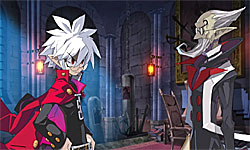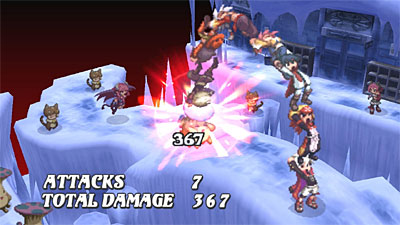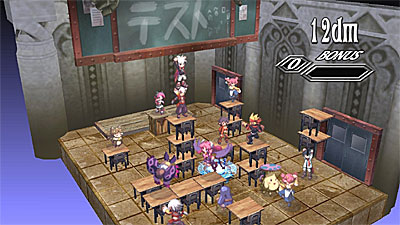Hundreds of Hours Later…
While it’s a relatively new franchise, Disgaea is hugely popular among many strategy RPG fans. Why? Because there’s just so much to it. Many games boast of a single feature that supposedly makes it fun; Disgaea has many. The series now makes the jump to the newest generation of gaming and, for the most part, it’s up to snuff. Disregarding a few minor shortcomings, SRPG fans as well as devotees of the series are definitely going to want to pick up Disgaea 3: Absence of Justice.

Like many SRPGs, Disgaea has you selecting characters, positioning them on a map, and then duking it out in turn-based style with enemies. On a character’s turn, he or she can move, attack, use a variety of skills, or perform one of several other actions.
This time around, the main character is Prince Mao who’s the number one student at the Academy of Evil (he got there by being an all-around bad kid – he’s never been to class once) and he’s out for vengeance against his father. The exceptional brand of humor that Disgaea fans have come to expect is back, but in Disgaea 3 it feels better than ever. The game is constantly funny but in a more subtle way than in past Disgaea titles, and all-around the story is well-done. In addition to being consistently funny, Absence of Justice also has some pretty serious and dramatic story sections.
While it excels in the humor department, Disgaea 3’s story is a bit shorter than that of past iterations of the series. There are eight chapters and the game will take quite a while to complete (a short game in the context of an SRPG is far different from a short game in the context of an action title or an FPS). On the plus side, the post-game options (that is, what you can do once you’ve cleared the main story) are greater than ever, and if you want, you can easily spend a couple hundred hours with this game.

There are three main components you’ll experience while playing Disgaea: the “hub”, the homeroom, and, of course, the countless, different battle maps. It’s at the homeroom where you’ll be working with most of your characters; you can create and modify them as well as place them next to each other at homeroom to increase their chemistry and allow them to perform powerful combinations.
At the “hub,” you’ll select characters and from there you’ll move out into the battle. As I already mentioned, Disgaea is a game known for its depth, and it definitely shows in Absence of Justice. Before you even start fighting, you’ve already got a wealth of options at your fingertips. Character-building is an addictive endeavor and constructing your ideal party is equally fun.

It’s not till you start fighting that things become really hectic to the point of being overwhelming. Moving and attacking are simple enough, but once you throw the complex skills and classes into the mix, things get a little crazy. Rather than gradually learning new skills as in Disgaea 2, Absence of Justice has you earning mana points for defeating enemies and then cashing those in to learn new skills. It’s a definite improvement over the last system, at least in my mind, and helps to somewhat streamline an already-confusing skill-gaining process.
The Academy World is a new feature to the Disgaea series, though it’s very similar to the Item World of the past games. At the Academy World, you’ll be able to not only buy new skills and abilities but also upgrade other various aspects of the many different characters that’ll join your party throughout the game. Each character is limited in terms of the different skills they can learn, but some solid character-building mechanics allows you to really customize the units in your party.
Absence of Justice boasts more than 60 different classes, and there’s a real sense of character progression that makes developing your different characters quite rewarding. Each class has “ranks,” and by mastering one rank, you’ll be able to move up to the next and become even more powerful. As you progress through the ranks, you’ll then gain access to new skills. The character progression feels smooth and intuitive and, overall, works quite well.

The battles themselves are a fun mix of strategy as well as implementing any abilities that your characters have mastered. Strategy isn’t a huge focus of the game, particularly if you’ve done a lot of level-grinding, but even so, the strategy and role-playing elements are fairly well-balanced. The maps are also quite large, which is an improvement over those of the last games. And finally, the pacing of Disgaea 3 is well-done. In many SRPGs, all the characters on the battlefield will move according to their speed, so you can have enemy and ally units taking turns moving. In Absence of Justice, all the units on a side move at the same time, which speeds up battles and makes fighting them less tedious.
As I previously touched on briefly, Disgaea 3 has an insane amount of replay value. Once you’ve cleared the main quest, there’s still a lot to do. Characters from past games make an appearance, and a plethora of new maps are opened up to you. It’s not out of the question to spend several hundred hours with this game if you’re a real SRPG junkie; even if you’re not, it’ll take quite a chunk of time just completing the story.
One of Disgaea 3’s few faults is the visual approach the game takes. It looks very similar to the past PS2 games, which is fairly disappointing considering the graphical capabilities of the PS3. That’s not to say the game looks bad, because it doesn’t. But despite being truly in 3D, you can’t help but feel that this game could have been done just as easily on the PS2 or PSP. It doesn’t really take anything away from the game because the gameplay is so well-done, but it is a minor let-down.
The only other complaint I really have with Disgaea 3 is one that’s been a problem throughout the entire series; there’s a lack of real guidance. If you’ve played a lot of SRPGs, you shouldn’t have much trouble figuring out the many intricacies of the game. But if you’re new to the genre, you’re going to have a lot of trouble muddling your way through the overwhelming game set-up.
Setting aside a couple near-negligible issues, Disgaea 3: Absence of Darkness is definitely one of the best SRPGs on the market. It holds its own with its predecessors and brings new content to the table, while keeping intact past items that have made the series so popular. Thanks to its rather steep learning curve, you’d best look elsewhere if you’re new to this genre. On the other hand, if you’re a fan of SRPGs or of Disgaea, this is a must-buy.
RATING OUT OF 5 RATING DESCRIPTION 2.8 Graphics
They’re not bad, but they look little more than hi-res versions of the PS2 editions of Disgaea. 4.2 Control
They’re nothing exceptional, but they work. Camera controls in particular are very much appreciated. 4.1 Music / Sound FX / Voice Acting
Some of the best music in the series, plus a ton of top-notch voice work and sound effects. 4.9 Play Value
There’s potential for hundreds of hours of gameplay. The gameplay is deep, rewarding, and addictive. 4.5 Overall Rating – Must Buy
Not an average. See Rating legend above for a final score breakdown.
Game Features:
